Hydrokinetic Energy and Transient Accelerations of Marine Currents in Colombian Nearshore Waters
Abstract
:1. Introduction
2. Materials and Methods
3. Results
3.1. Time-Frequency Domain Analysis
3.2. Transient Hydrodynamic Accelerations
4. Discussion
Dynamics of the Water Column
5. Conclusions
Author Contributions
Funding
Data Availability Statement
Acknowledgments
Conflicts of Interest
List of Symbols and Abbreviatures
| ah | Horizontal acceleration (m/s2) |
| av | Vertical acceleration (m/s2) |
| Hs. | Wave height (m) |
| Tp | Peak period (s) |
| u, v, w | Wave orbital velocities (m/s) |
| SST | Sea surface temperature (°C) |
| SSS | Sea surface salinity (ppt) |
| P | Daily accumulated precipitation (mm) |
| Ws | Wind speed (m/s) |
| Wd | Wind direction (°) |
| SST | Sea Surface Temperature (°C) |
| rho | Water density (kg/m3) |
| Ri | Richardson number |
| TKE | Turbulent kinetic energy (m2/s2) |
| ADCP | Acoustic Doppler Current profiler |
| AST | Acoustic Surface Tracking |
| CLLJ | Caribbean Low-Level Jet winds |
| CCC | Counter Caribbean Current |
| CIOH | Oceanographic and Hydrographic Research Center |
| DDC | Double-diffusive convection |
| PCCC | Panama Colombia Counter Current |
| NARR | NCEP-North American Regional Reanalysis database |
| PD | Pressure spectral curves |
| u, v | Horizontal velocity components |
| U | Horizontal velocity resultant |
| LWE | Low wind event |
| HWE | High wind event |
References
- Stephens, S.A.; Ramsay, D.L. Extreme Cyclone Wave Climate in the Southwest Pacific Ocean: Influence of the El Niño Southern Oscillation and Projected Climate Change. Glob. Planet. Chang. 2014, 123, 13–26. [Google Scholar] [CrossRef] [Green Version]
- Roy, B.; Penha-Lopes, G.P.; Uddin, M.S.; Kabir, M.H.; Lourenço, T.C.; Torrejano, A. Sea Level Rise Induced Impacts on Coastal Areas of Bangladesh and Local-Led Community-Based Adaptation. Int. J. Disaster Risk Reduct. 2022, 73, 102905. [Google Scholar] [CrossRef]
- Hendrix, C.S.; Glaser, S.M.; Lambert, J.E.; Roberts, P.M. Global Climate, El Niño, and Militarized Fisheries Disputes in the East and South China Seas. Mar. Policy 2022, 143, 105137. [Google Scholar] [CrossRef]
- Xu, H.; Zhuang, C.C.; Guan, X.; He, X.; Wang, T.; Wu, R.; Zhang, Q.; Huang, W. Associations of Climate Variability Driven by El Niño-Southern Oscillation with Excess Mortality and Related Medical Costs in Chinese Elderly. Sci. Total Environ. 2022, 851, 158196. [Google Scholar] [CrossRef]
- Paz, S.; Semenza, J.C. El Niño and Climate Change—Contributing Factors in the Dispersal of Zika Virus in the Americas? Lancet 2016, 387, 745. [Google Scholar] [CrossRef] [Green Version]
- Rueda-Bayona, J.G.; Guzmán, A.; Eras, J.J.C.; Silva-Casarín, R.; Bastidas-Arteaga, E.; Horrillo-Caraballo, J. Renewables Energies in Colombia and the Opportunity for the Offshore Wind Technology. J. Clean. Prod. 2019, 220, 529–543. [Google Scholar] [CrossRef]
- Gato, L.M.C.; Henriques, J.C.C.; Carrelhas, A.A.D. Sea Trial Results of the Biradial and Wells Turbines at Mutriku Wave Power Plant. Energy Convers. Manag. 2022, 268, 115936. [Google Scholar] [CrossRef]
- Rueda-Bayona, J.G.; Guzmán, A.; Cabello Eras, J.J. Selection of JONSWAP Spectra Parameters during Water-Depth and Sea-State Transitions. J. Waterw. Port Coast. Ocean Eng. 2020, 146, 04020038. [Google Scholar] [CrossRef]
- Rueda-Bayona, J.G.; Osorio-Arias, A.; Guzmán, A.; Rivillas-Ospina, G. Alternative Method to Determine Extreme Hydrodynamic Forces with Data Limitations for Offshore Engineering. J. Waterw. Port Coast. Ocean Eng. 2018, 145, 16. [Google Scholar] [CrossRef]
- Rueda-Bayona, J.G.; Gil, L.; Calderón, J.M. CFD-FEM Modeling of a Floating Foundation under Extreme Hydrodynamic Forces Generated by Low Sea States. Math. Model. Eng. Probl. 2021, 8, 888–896. [Google Scholar] [CrossRef]
- Pichault, M.; Vincent, C.; Skidmore, G.; Monty, J. LiDAR-Based Detection of Wind Gusts: An Experimental Study of Gust Propagation Speed and Impact on Wind Power Ramps. J. Wind Eng. Ind. Aerodyn. 2022, 220, 104864. [Google Scholar] [CrossRef]
- Tan, K.; Islam, S. Optimum Control Strategies in Energy Conversion of PMSG Wind Turbine System without Mechanical Sensors. IEEE Trans. Energy Convers. 2004, 19, 392–399. [Google Scholar] [CrossRef]
- Xie, T.; Wang, T.; He, Q.; Diallo, D.; Claramunt, C. A Review of Current Issues of Marine Current Turbine Blade Fault Detection. Ocean Eng. 2020, 218, 108194. [Google Scholar] [CrossRef]
- Rueda-Bayona, J.G.; Paez, N.; Eras, J.J.C.; Gutiérrez, A.S. DOE-ANOVA to optimize hydrokinetic turbines for low velocity conditions. Math. Model. Eng. Probl. 2022, 9, 979–988. [Google Scholar] [CrossRef]
- Li, Y.; Wang, C.; Liang, C.; Li, J.; Liu, W. A Simple Early Warning Method for Large Internal Solitary Waves in the Northern South China Sea. Appl. Ocean Res. 2016, 61, 167–174. [Google Scholar] [CrossRef]
- Sato, M.; Klymak, J.M.; Kunze, E.; Dewey, R.; Dower, J.F. Turbulence and Internal Waves in Patricia Bay, Saanich Inlet, British Columbia. Cont. Shelf Res. 2014, 85, 153–167. [Google Scholar] [CrossRef]
- Haibin, L.; Xie, J.; Xu, J.; Chen, Z.; Liu, T.; Cai, S. Force and Torque Exerted by Internal Solitary Waves in Background Parabolic Current on Cylindrical Tendon Leg by Numerical Simulation. Ocean Eng. 2016, 114, 250–258. [Google Scholar] [CrossRef]
- Chen, M.; Chen, K.; You, Y.X. Experimental Investigation of Internal Solitary Wave Forces on a Semi-Submersible. Ocean Eng. 2017, 141, 205–214. [Google Scholar] [CrossRef]
- Bastidas-Salamanca, M.; Gabriel Rueda-Bayona, J. Pre-Feasibility Assessment for Identifying Locations of New Offshore Wind Projects in the Colombian Caribbean. Int. J. Sustain. Energy Plan. Manag. 2021, 32, 139–154. [Google Scholar] [CrossRef]
- Ortega, S.; Osorio, A.F.; Agudelo, P. Estimation of the Wave Power Resource in the Caribbean Sea in Areas with Scarce Instrumentation. Case Study: Isla Fuerte, Colombia. Renew. Energy 2013, 57, 240–248. [Google Scholar] [CrossRef]
- Orejarena-Rondón, A.F.; Restrepo, J.C.; Correa-Metrio, A.; Orfila, A. Wave Energy Flux in the Caribbean Sea: Trends and Variability. Renew. Energy 2022, 181, 616–629. [Google Scholar] [CrossRef]
- Bastidas-Salamanca, M.; Rueda-Bayona, J.G. Effect of Climate Variability Events over the Colombian Caribbean Offshore Wind Resource. Water 2021, 13, 3150. [Google Scholar] [CrossRef]
- Osorio, A.F.; Ortega, S.; Arango-Aramburo, S. Assessment of the Marine Power Potential in Colombia. Renew. Sustain. Energy Rev. 2016, 53, 966–977. [Google Scholar] [CrossRef]
- Andrade, C.A.; Barton, E.D.; Mooers, C.N.K. Evidence for an Eastward Flow along the Central and South American Caribbean Coast. J. Geophys. Res. Ocean. 2003, 108, 16. [Google Scholar] [CrossRef] [Green Version]
- Fernando Pareja Román, L.; Cristina Díaz Guevara, D.; Tatiana Rodríguez Tobar, Á.; Liliana Villegas Bolaños, N.; Ernesto Pérez Santos, I.; Pérez, N. Análisis Del Transporte y Bombeo de Ekman En El Caribe Colombiano Entre 1999 y 2009. Bol. Cient. CIOH 2013, 31, 3–12. [Google Scholar] [CrossRef]
- Orfila, A.; Urbano-Latorre, C.P.; Sayol, J.M.; Gonzalez-Montes, S.; Caceres-Euse, A.; Hernández-Carrasco, I.; Muñoz, Á.G. On the Impact of the Caribbean Counter Current in the Guajira Upwelling System. Front. Mar. Sci. 2021, 8, 128. [Google Scholar] [CrossRef]
- NORTEK. The Comprehensive Manual–ADCP. Available online: https://www.nortekgroup.com/fr/products/awac-600-khz/pdf (accessed on 11 July 2023).
- Holthuijsen, L.H. Waves in Oceanic and Coastal Waters; Cambridge University Press: Cambridge, MA, USA, 2007; ISBN 978-0-51-161853-6. [Google Scholar]
- NORTEK. Ocean Waves. Available online: https://www.nortekgroup.com/products/awac-600-khz (accessed on 27 July 2023).
- NOAA NCEP. North American Regional Reanalysis: NARR. Available online: https://psl.noaa.gov/data/gridded/data.narr.html (accessed on 27 July 2023).
- DIMAR-CIOH. CIOH. Climatología de Los Principales Puertos Del Caribe Colombiano-Barranquilla; Dirección General Marítima: Cartageina de Indias, Colombia, 2010; Available online: https://www.cioh.org.co/index.php/en/areas-del-conocimiento/sm-oceanografia-operacional/productos-y-servicios-arope/climatologia-puertos-caribe-colombiano (accessed on 1 May 2023).
- Deltares Delft3D-FLOW. Simulation of Multi-Dimensional Hydrodynamic Flows and Transport Phenomena, Including Sediments–User Manual. 2014. Available online: https://usermanual.wiki/Pdf/Delft3DFLOWUserManual.885467064/help (accessed on 27 July 2023).
- Bastidas Salamanca, M.L.; Figueroa Casas, A. Seguimiento Satelital de Las Condiciones Océano-Atmosféricas Asociadas a Los Eventos de Precipitación En Colombia Durante El Evento La Niña 2010–2011. Bol. Cient. CIOH 2014, 32, 123–134. [Google Scholar] [CrossRef]
- Andrade, C. Análisis de La Velocidad Del Viento En El Mar Caribe. Bol. Cient. CIOH 1993, 15, 33–43. [Google Scholar] [CrossRef]
- Wang, C.; Lee, S.K. Atlantic Warm Pool, Caribbean Low-Level Jet, and Their Potential Impact on Atlantic Hurricanes. Geophys. Res. Lett. 2007, 34. [Google Scholar] [CrossRef] [Green Version]
- Amador, J.A.; Alfaro, E.J.; Lizano, O.G.; Magaña, V.O. Atmospheric Forcing of the Eastern Tropical Pacific: A Review. Prog. Oceanogr. 2006, 69, 101–142. [Google Scholar] [CrossRef]
- Amador, J.A. The Intra-Americas Sea Low-Level Jet: Overview and Future Research. Ann. N. Y. Acad. Sci. 2008, 1146, 153–188. [Google Scholar] [CrossRef] [PubMed] [Green Version]
- Wang, C. Variability of the Caribbean Low-Level Jet and Its Relations to Climate. Clim. Dyn. 2007, 29, 411–422. [Google Scholar] [CrossRef] [Green Version]
- DIMAR-CIOH. Pronóstico Climático Del Caribe Colombiano Junio 2015; Dirección General Marítima: Cartagena de Indias, Colombia, 2015. [Google Scholar] [CrossRef] [Green Version]
- Schmitt, R.W.; Ledwell, J.R.; Montgomery, E.T.; Polzin, K.L.; Toole, J.M. Enhanced Diapycnal Mixing by Salt Fingers in the Thermocline of the Tropical Atlantic. Science 2005, 308, 685–688. [Google Scholar] [CrossRef] [PubMed]
- Hirano, D.; Kitade, Y.; Nagashima, H.; Matsuyama, M. Characteristics of Observed Turbulent Mixing across the Antarctic Slope Front at 140°E, East Antarctica. J. Oceanogr. 2010, 66, 95–104. [Google Scholar] [CrossRef]
- Nakano, H.; Yoshida, J. A Note on Estimating Eddy Diffusivity for Oceanic Double-Diffusive Convection. J. Oceanogr. 2019, 75, 375–393. [Google Scholar] [CrossRef] [Green Version]
- Muñoz, E.; Busalacchi, A.J.; Nigam, S.; Ruiz-Barradas, A. Winter and Summer Structure of the Caribbean Low-Level Jet. J. Clim. 2008, 21, 1260–1276. [Google Scholar] [CrossRef] [Green Version]
- Whyte, F.S.; Taylor, M.A.; Stephenson, T.S.; Campbell, J.D. Features of the Caribbean Low Level Jet. Int. J. Climatol. 2008, 28, 119–128. [Google Scholar] [CrossRef]
- Villegas, N.; Malikov, I.; Farneti, R. Sea Surface Temperature in Continental and Insular Coastal Colombian Waters: Observations of the Recent Past and near-Term Numerical Projections. Lat. Am. J. Aquat. Res. 2021, 49, 307–328. [Google Scholar] [CrossRef]
- Latandret-Solana, S.A.; Torres Parra, R.R.; Herrera Moyano, D.P. Ocean Tides in the Colombian Basin and Atmospheric Contribution to S2. Dyn. Atmos. Ocean. 2023, 102, 101356. [Google Scholar] [CrossRef]
- Rueda-Bayona, J.G.; Carrillo, J.; Cabello Eras, J.J. The Wind-Current-Water Levels Effect over Surface Wave Parameters Nearby the Magdalena River Delta: A Numerical Approach. Math. Model. Eng. Probl. 2023, 10, 993–1002. [Google Scholar] [CrossRef]
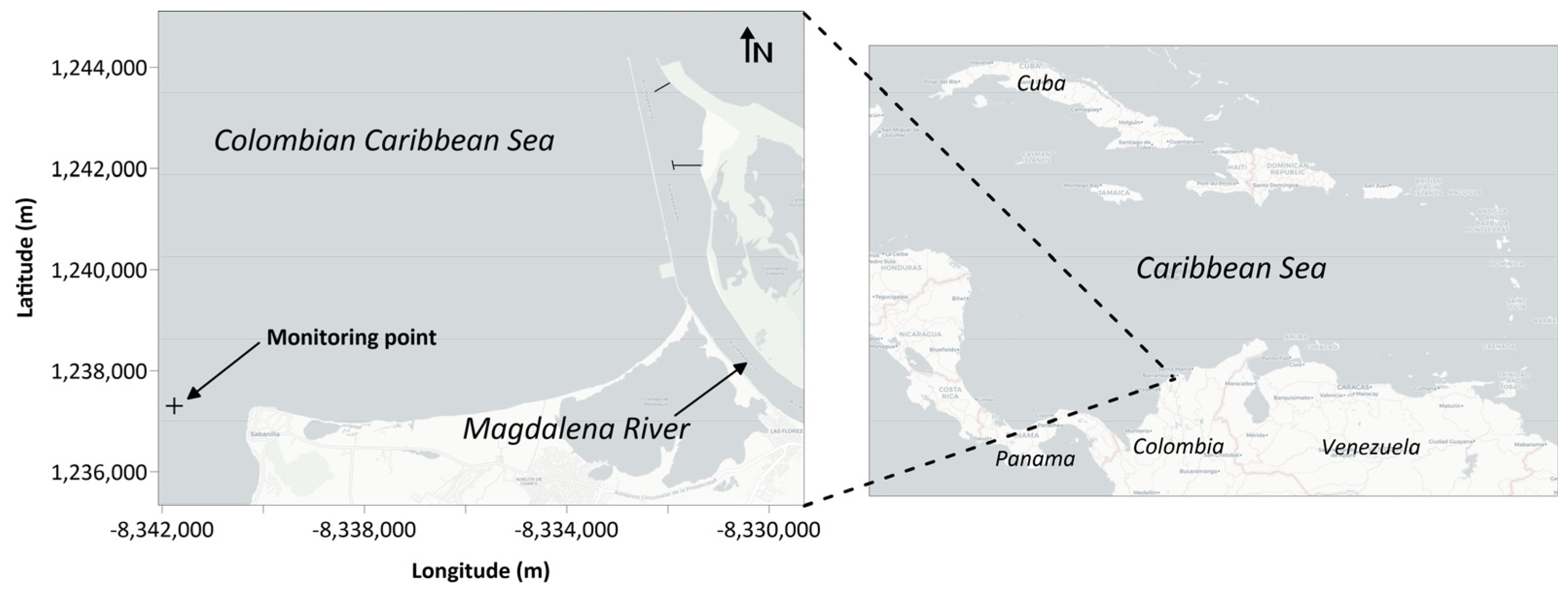
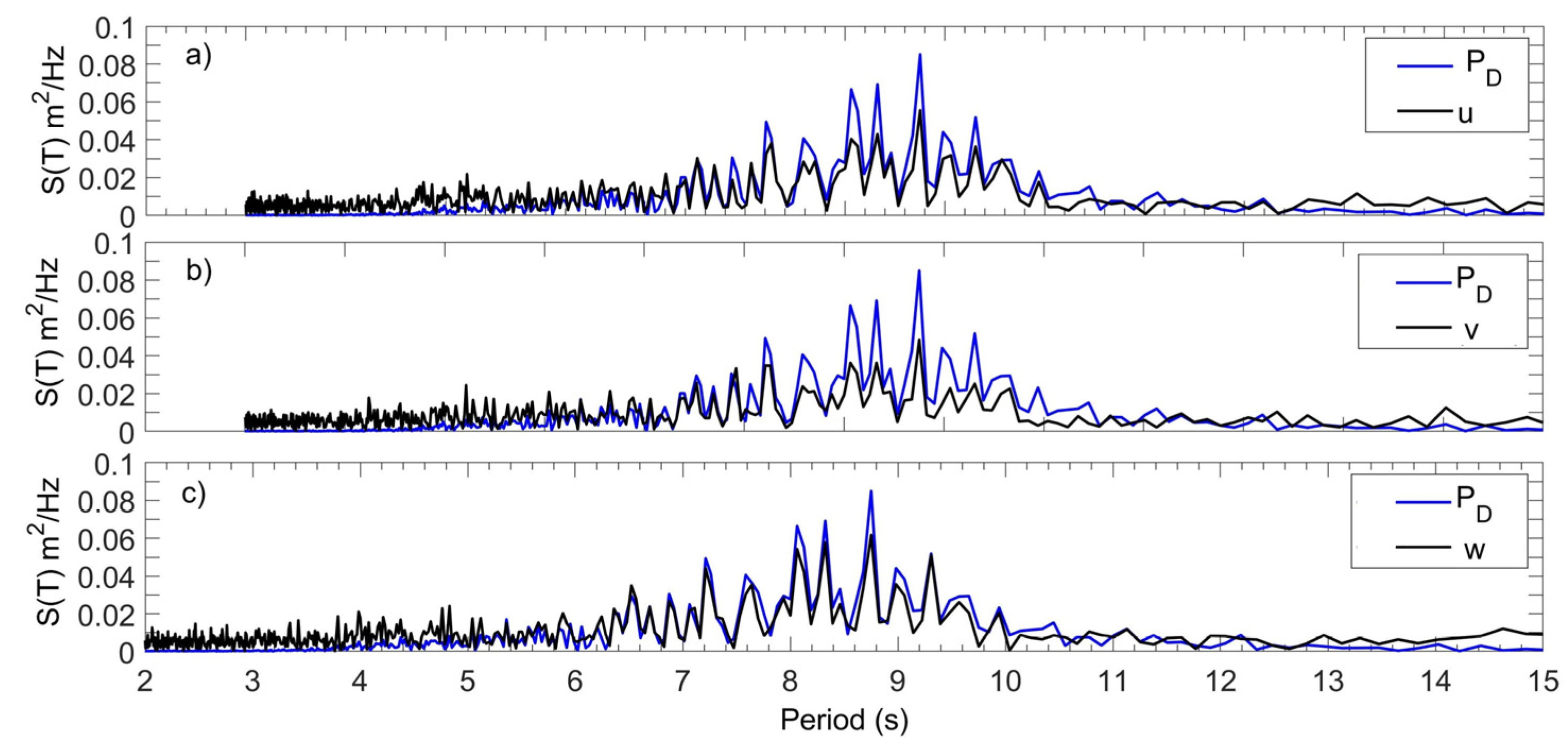
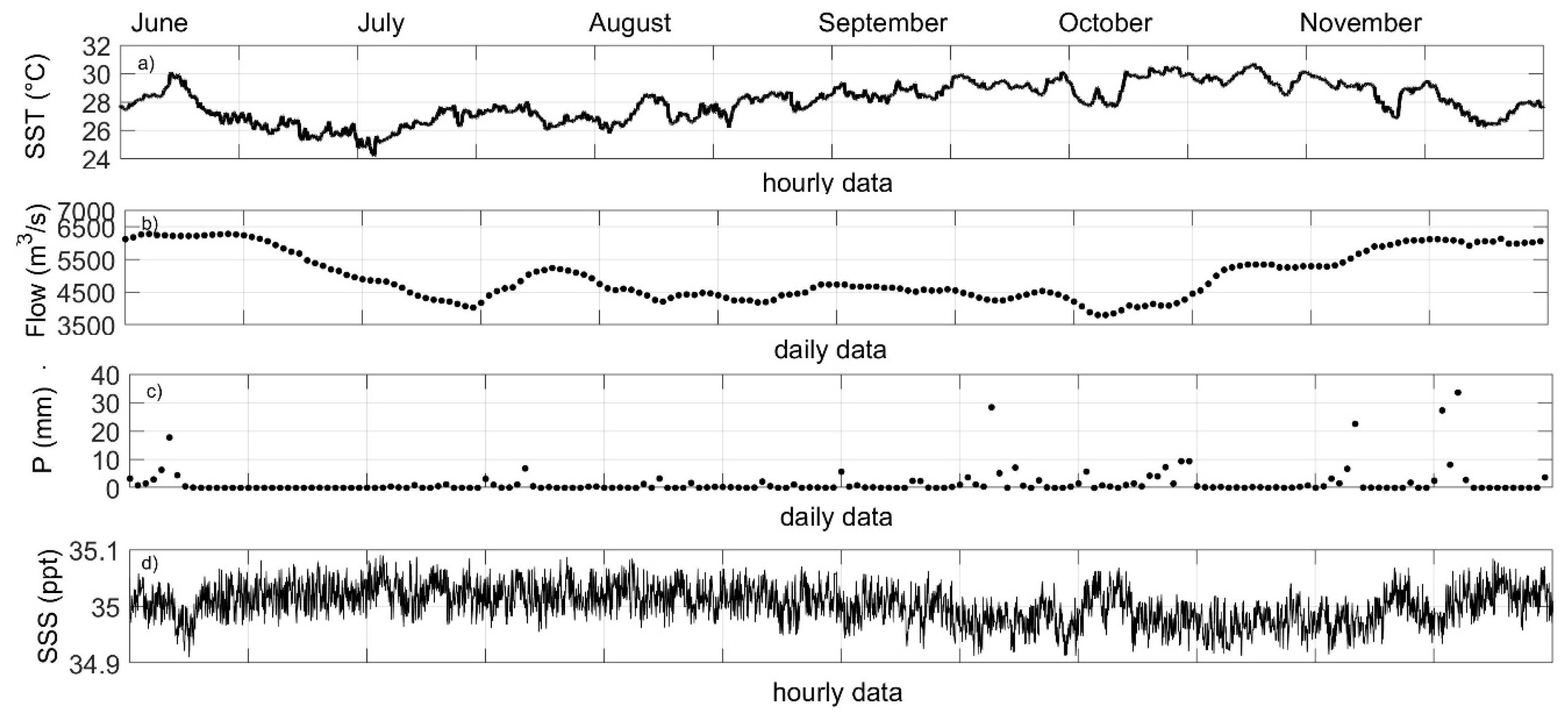




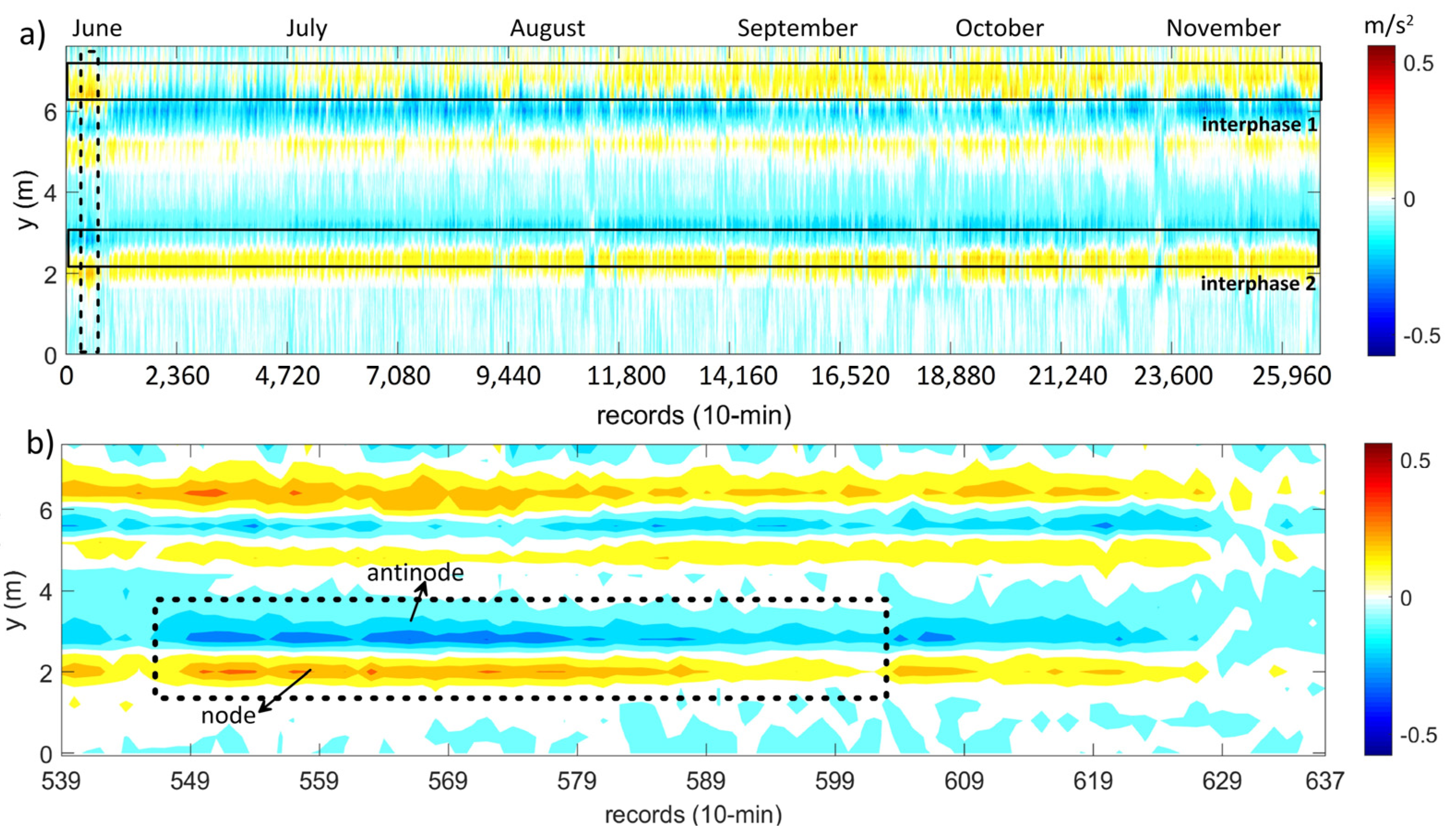



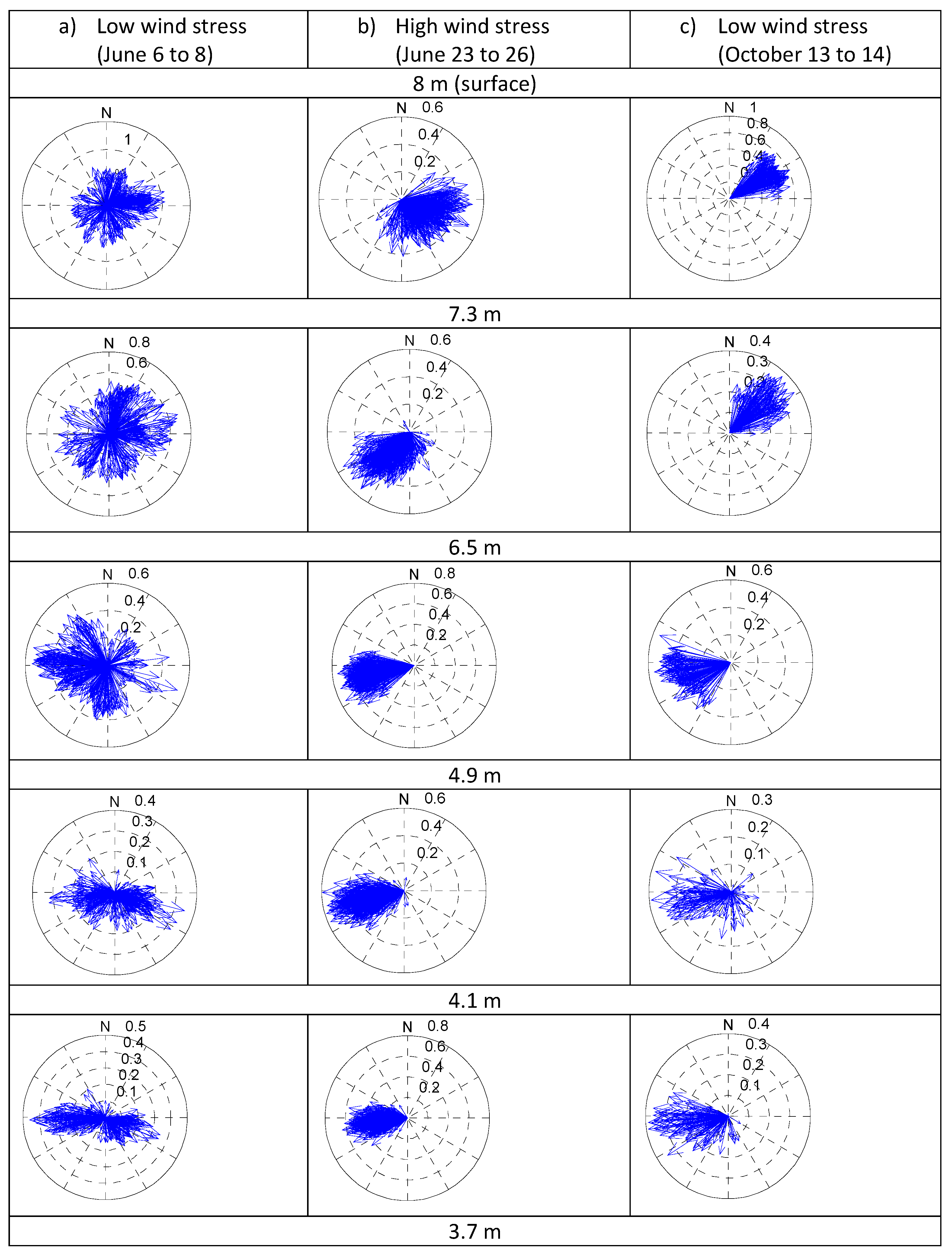
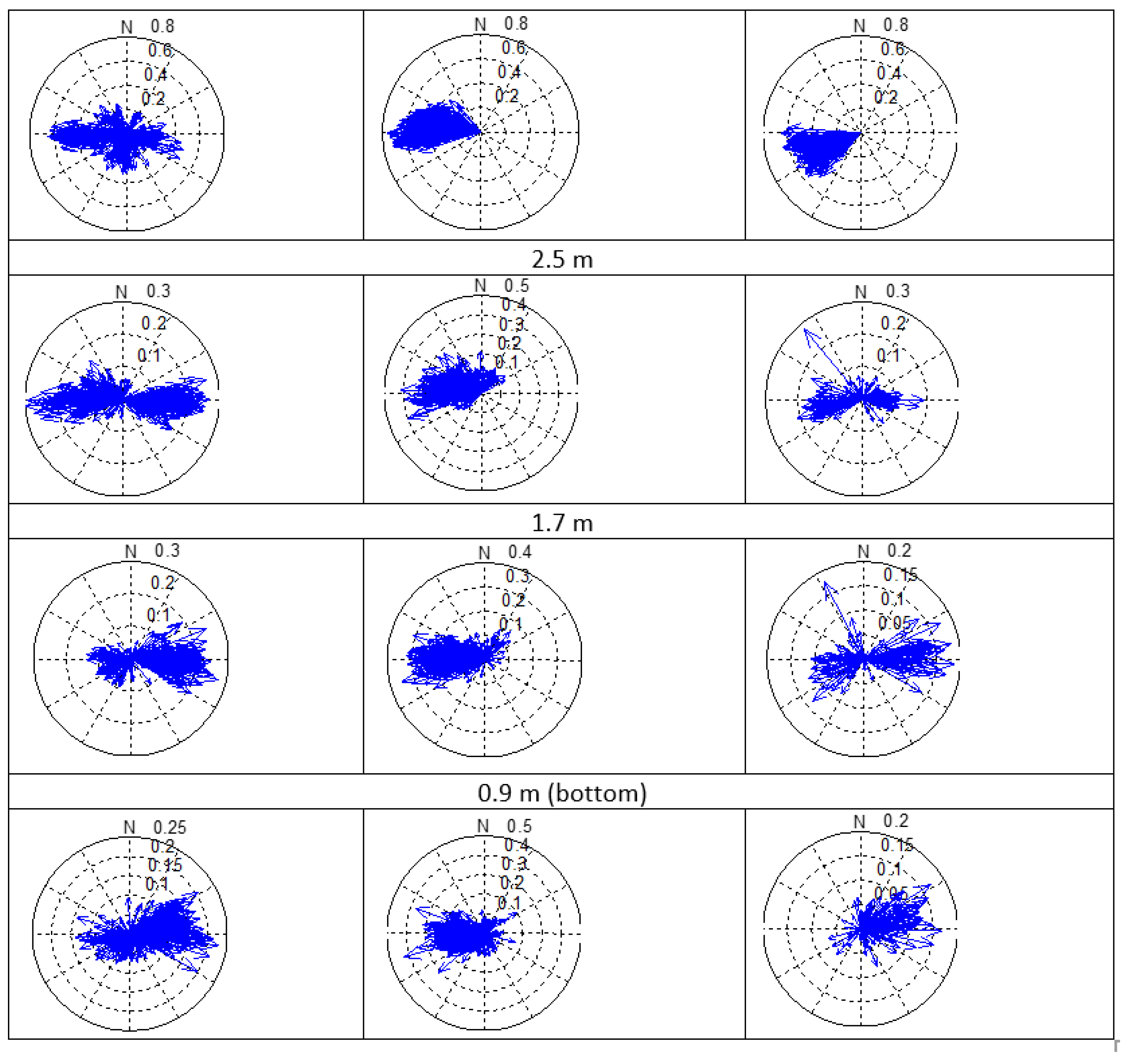

| Parameter | Elapsed Time (dd-mm-yyyy-hh) | Time Interval (h) | Duration of Each Measurement Event (min) | Measurement Frequency of Each Event (Hz). |
|---|---|---|---|---|
| Hydrostatic pressure at bottom (dbar) | 03-06-2015- 12 to 11-12- 2015-18 | 1 | 10 | 1 |
| 3D Orbital wave velocities (m/s) | 03-06-2015- 12 to 11-12- 2015-18 | 1 | 17 | 2 |
| Free surface (m) | 03-06-2015- 12 to 11-12- 2015-18 | 1 | 17 | 2 |
| Temperature (°C) | 03-06-2015- 12 to 11-12- 2015-18 | 1 | 17 | 2 |
| Horizontal current velocity (m/s) | 03-06-2015- 12 to 11-12- 2015-18 | 1 | 10 | 1 |
Disclaimer/Publisher’s Note: The statements, opinions and data contained in all publications are solely those of the individual author(s) and contributor(s) and not of MDPI and/or the editor(s). MDPI and/or the editor(s) disclaim responsibility for any injury to people or property resulting from any ideas, methods, instructions or products referred to in the content. |
© 2023 by the authors. Licensee MDPI, Basel, Switzerland. This article is an open access article distributed under the terms and conditions of the Creative Commons Attribution (CC BY) license (https://creativecommons.org/licenses/by/4.0/).
Share and Cite
Rueda-Bayona, J.G.; Cabello Eras, J.J.; Caicedo-Laurido, A.L.; Guzmán, A.; García Vélez, J.L. Hydrokinetic Energy and Transient Accelerations of Marine Currents in Colombian Nearshore Waters. Water 2023, 15, 2725. https://doi.org/10.3390/w15152725
Rueda-Bayona JG, Cabello Eras JJ, Caicedo-Laurido AL, Guzmán A, García Vélez JL. Hydrokinetic Energy and Transient Accelerations of Marine Currents in Colombian Nearshore Waters. Water. 2023; 15(15):2725. https://doi.org/10.3390/w15152725
Chicago/Turabian StyleRueda-Bayona, Juan Gabriel, Juan José Cabello Eras, Ana Lucía Caicedo-Laurido, Andrés Guzmán, and José Luis García Vélez. 2023. "Hydrokinetic Energy and Transient Accelerations of Marine Currents in Colombian Nearshore Waters" Water 15, no. 15: 2725. https://doi.org/10.3390/w15152725
APA StyleRueda-Bayona, J. G., Cabello Eras, J. J., Caicedo-Laurido, A. L., Guzmán, A., & García Vélez, J. L. (2023). Hydrokinetic Energy and Transient Accelerations of Marine Currents in Colombian Nearshore Waters. Water, 15(15), 2725. https://doi.org/10.3390/w15152725







